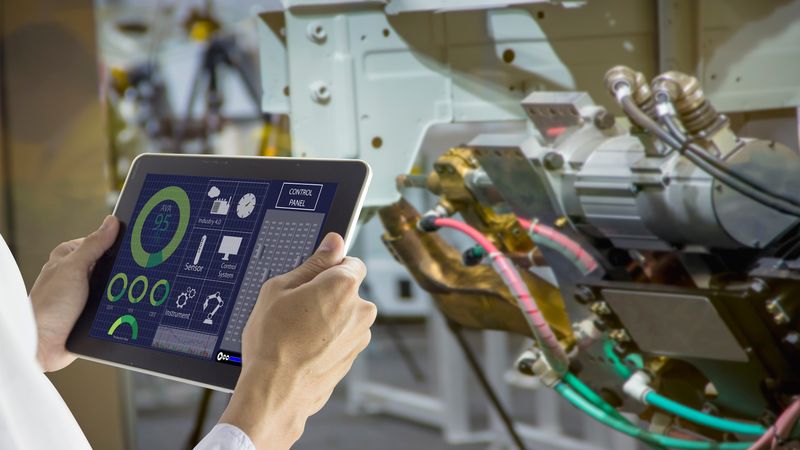How SBCs can lead the way to predictive maintenance
SBCs provide the means to create affordable and customizable solutions to integrate predictive maintenance into your production process.
In manufacturing, time is a vital resource to be managed. Any broken or malfunctioning equipment can lead to downtime, which can result in operational and economic losses. Therefore, maintenance is essential to keep industrial processes efficient, save money, increase safety, lengthen asset lifespan and avoid unexpected breakdowns.
Maintenance management, associated with predictive and preventive maintenance, emerged as a more efficient alternative to the traditional corrective approach. Predictive maintenance (PdM) is a technique that monitors the data from sensors and uses statistical or AI models to define when maintenance is necessary. It reduces the likelihood of unnecessary stops and prompts the operator to repair equipment at the right time, making the process more efficient and reducing costs with corrective maintenance. McKinsey & Company reports that AI-based PdM can increase asset productivity by up to 20% and reduce maintenance costs by up to 10% ¹.
This article explores how single-board computers (SBCs) can be used to create affordable and customizable solutions that meet the maintenance requirements of your equipment.
How PdM works
PdM frameworks comprise several devices and systems that are combined to perform the following functions:
- Data acquisition and processing: receive and pre-process the data from sensors, for example.
- Analysis and prediction: based on historical data and AI models, it monitors and identifies operational states and predicts malfunction or failures.
- Reporting and warning: based on the analysis and prediction, it generates alerts and reports or even schedules the maintenance and allocates the necessary resources.
Therefore, the technology used to acquire, monitor, and analyze the data from equipment will impact the effectiveness of the PdM system.
Challenges of adopting PdM
A significant challenge of implementing a PdM system is related to data acquisition. You have to identify the best indicators for each equipment and ensure that your PdM software acquires and delivers accurate data. For electric motors, for example, you may need to measure voltages, currents, temperatures, and vibrations, so if your factory has hundreds or thousands of machines, this process becomes very complex.
After defining the indicators, you need to select the right system to receive, process, and transmit the sensor data to the central system. This system runs on the cloud or industry server and is responsible for analyzing, predicting, reporting, and warning. Therefore, the Edge system must have enough processing power, sensor compatibility, and connectivity to the server.
Benefits of using SBCs in PdM systems
Depending on your maintenance demands, commercial solutions may not provide all the required functionalities or capacity. Therefore, developing a customized data acquisition and processing system is often the best option.
Considering the requirements to implement a PdM setup, IoT systems that use an Edge architecture can be a great resource. They offer design flexibility, efficient data collection and monitoring, and a continuous connection to the server. However, its implementation relies on developing specialized systems composed of multiple devices, such as sensors, requiring a processing unit to centralize and process all the information.
SBCs are a prominent solution for the Edge computing IoT devices demanded by PdM systems. They provide the required processing power and a wide range of connections and support communication protocols, such as I2C, to interact with sensors and the server. Furthermore, SBCs are reliable, energy-efficient, compact, and affordable.
Most SBCs have built-in wireless communication features, which simplify the connection with the server. Moreover, they provide several general-purpose inputs/outputs (GPIO) where you can connect sensors for data acquisition. Depending on the application, you can create a local user interface to identify anomalies locally instead of relying on server reports.
Application examples
You can apply the PdM approach to basically all equipment in the production process or even to the building. Below we explore one application example using the ROCK series of SBCs.
PdM for rotating machines
Rotating machines are common in many industrial processes and crucial for several of them. For example, refrigeration is critical to the meat processing industry and uses powerful electric motors. In this application, performing predictive maintenance can avoid breakdowns and downtime, saving money and increasing efficiency.
Two main goals can be set for a PdM covering rotating machines: 1) monitor and identify the current operational state; 2) predict failures to manage maintenance procedures. Both processes require acquiring and processing operational information of the machine, such as current, voltage, and vibration. In order to measure and process these data, a setup composed of the following components could be implemented:
- An SBC to receive, process, and transmit the measured data. You can use the model ROCK 4 SE for this application, which provides serial communication capabilities, high processing power enabled by a Hexa-core processor with big.LITTLE™ Arm® Dual Cortex-A72® CPU, Quad-core Cortex-A53 and Arm Mali™ - T860MP4 GPU, ethernet and USB connections, and a wireless connection that support 2.4GHz/5GHz WiFi networks.
- A platform to monitor the operational state. You can build a web application or use a cloud platform, such as ThingSpeak. In this case, you could connect a display to the SBC with the equipment, since the ROCK 4 SE, which supports 4K@60 HDMI.
- A LSM9DS1 Inertial Measurement Units (IMU) module, which supports I2C and SPI protocols, to get vibrations information.
- A voltage sensor such as the V500-ISO. However, you must ensure it supports the maximum voltage of your grid, which in most cases, will not go over 500V.
- A current sensor such as the HTP200-P. However, you must ensure that its current sensing capacity is compatible with the machine's current consumption.
To identify the operational state and predict failures, you would need to prepare a dataset for training the AI algorithms. Since identifying operational states and predicting failures are different goals, the best option is to develop two separate AI systems. This approach would simplify the training process and help you achieve results with high accuracy. Both applications will deal with temporal data. Therefore, Recurrent Neural Networks (RNN) are a good option to deal with it. Another option is to use Continuous RNN with adversarial training, particularly to predict failures. Summarizing, the process of developing the AI system will consist of the following steps:
- Data acquisition using sensors
- Feature extraction and identification
- Development of predictive models to classify data
- Deploy the system
The devices presented in the previous diagram are used in steps 1 and 4. In the data acquisition phase, the system is installed on the electric machine running in the production line to monitor its operation. However, this approach can be ineffective. To accelerate the data acquisition process, you can emulate a machine's operational states and failures outside the production process. In this stage, the ROCK pre-processes and transmits the data to the server.
The feature extraction and identification will define the number of states identified, and possible failures predicted. For example, you may be concerned about identifying only four operational states: stop mode, normal operation mode, block mode, and rotor imbalance mode. Therefore, the training dataset should have enough examples to train the AI system properly.
The same happens for the failure prediction system. In this case, you may want to predict failures such as, but not limited to, wear and damage of bearing, internal or external short circuits, breakdown of the winding’s insulation, and shaft failure. The success of your AI systems will strongly depend on the dataset used for training, as large and more diversified the dataset, the higher the system accuracy.
You can train the AI systems with the training dataset in hand. In this stage, you will define the network size and configuration and train your models. After training the AI systems, you can deploy them on the ROCK and start using the PdM system. The sensors will acquire the data and send it to the ROCK, which will pre-process it before using the AI algorithms. The AI outputs with the current operational state and possible failures predicted are then transmitted to the server. If some problem or anomaly is detected, the monitoring system can alert the maintenance team to fix it.
ROCK series of SBCs from Okdo
The ROCK family is a group of SBCs developed in collaboration between OKdo and Radxa. They cover some possible needs regarding SBC applications, with some boards having wireless connections, general purpose input/output (GPIO), and serial communication capacity. For applications with size restriction and low processing power requirements, you can use the ROCK 5B which has a quad-core processor packed into a 1.7inch square. For video or high-processing demanding applications such as high storage capacity and camera connection, you could use one SBC from the ROCK 4 family, such as the ROCK 4 SE. This model supports up to 800 MP camera and comes with an M.2 connector that supports up to 2TB M2 NVME SSD.
If your project requires a customized solution based on SBCs, the OKdo team can work with you to understand your requirements and provide a fully customized ROCK board.
ROCK Pi S, ROCK Pi E and the ROCK 4 family, use Rockchip semiconductors. Rockchip uses several different fabs to produce their wafers, meaning they have been able to ride the supply chain storm. Therefore, choosing the ROCK SBCs you minimize the risk of dealing with the recent supply chain constraints.
The ROCK Engineering Challenge
Do you have an idea of how to use the ROCK? The challenge is open to all OEM's, startups, research teams, and students working on innovative SBC applications. Show the world what you can create with cutting-edge single-board computer hardware.
We invite engineers, entrepreneurs, inventors, and developers to submit an idea for a part, product, or system that takes advantage of the ROCK single-board computers.
- The first 500 valid entries will receive a ROCK board of choice worth $45 - $159.
Simply tell us what you are working on, and we'll send you a piece of cutting-edge hardware to bring your ideas to life. - The most-cutting edge entry will be rewarded with a grand prize of a $50,000 partnership with electronics company OKdo to scale up their project idea.
The challenge is now open until April 12th, 2023. Read more here.
How to Enter?
Submit your entry via this form. You will be asked for a comprehensive idea description, details of your team, and images or videos that support your idea. The challenge is open until April 12, 2023.
We can’t wait to see your entries!
About the sponsor: OKdo
OKdo is a brand delivering a unique combination of hardware, software, development, and manufacturing services to help customers turn their innovative ideas into commercial realities. The company has been endorsed by technology giants such as Arm, NXP, Broadcom, Intel, and SEEED. OKdo partners with different brands to bring the latest and most innovative IoT and SBC products to people around the world.
References
[1] McKinsey & Company, “Smartening up with Artificial Intelligence (AI) – What’s in it for Germany and its Industrial Sector?”
[2] ASSET, “Challenges Faced While Implementing Predictive Maintenance”
[3] Chuang, Shang-Yi, Nilima Sahoo, Hung-Wei Lin, and Yeong-Hwa Chang. 2019. "Predictive Maintenance with Sensor Data Analytics on a Raspberry Pi-Based Experimental Platform"
[4] Katona, A., and P. Panfilov. "Building predictive maintenance framework for smart environment application systems."



